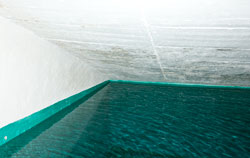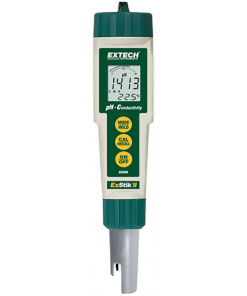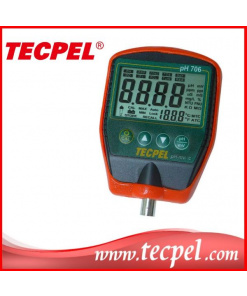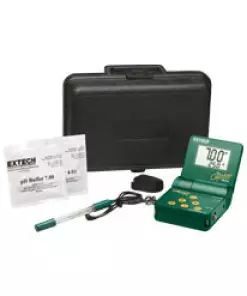Filtrate Dry Residue Meter
Filtrate Dry Residue Meter for determining the pH value, the conductivity, the filtrate dry residue / Display of salinity / Determination of sample temperature / IP67 protected ABS housing / Measurement data memory for 50 data sets
The Filtrate Dry Residue Meter provides the user with comprehensive measurement applications. In addition to determining the pH value, the Filtrate Dry Residue pH Meter also shows the conductivity, the filtrate dry residue, the salinity and the temperature of the sample. The Filtrate Dry Residue Meter is a measuring instrument for mobile measurement. In order to facilitate the most comfortable transport, the Filtrate Dry Residue Meter is supplied with a practical belt clip into which the measuring instrument can be inserted. In contrast to a normal Filtrate Dry Residue Meter, there are many possibilities to perform a liquid analysis.
The scope of application ranges from the diagnosis of private aquariums to the examination of water bodies or swimming pools. The measured values can be read directly on the display. In addition, these measured values can be stored directly on the internal measured value memory via the function keys.
 As a rule, many substances and liquids are compounds, consisting of different organic and non-organic elements. To find out in which amounts are present in this or another sample, it is necessary to carry out certain procedures and measurements, for example with a filtrate dry residue meter. Thus, to obtain the dry residue out of the water / liquid sample it is necessary to evaporate the sample at a particular temperature (average, 105 °C). The unit for the residue that remains is expressed in mg per 1l. Sometimes, besides dry residue, the dense residue may be determined (the procedure is similar, just in one case the sample is filtered and in another it should be unfiltered and after evaporation the residue is dried till the weight remains unchanged). The difference between these two residues indicates the presence of the coarse-dispersed impurities and insoluble particles in the sample. As a rule, the difference between them in drinking water is absolutely small, what cannot be said about sewage and dirty water.
As a rule, many substances and liquids are compounds, consisting of different organic and non-organic elements. To find out in which amounts are present in this or another sample, it is necessary to carry out certain procedures and measurements, for example with a filtrate dry residue meter. Thus, to obtain the dry residue out of the water / liquid sample it is necessary to evaporate the sample at a particular temperature (average, 105 °C). The unit for the residue that remains is expressed in mg per 1l. Sometimes, besides dry residue, the dense residue may be determined (the procedure is similar, just in one case the sample is filtered and in another it should be unfiltered and after evaporation the residue is dried till the weight remains unchanged). The difference between these two residues indicates the presence of the coarse-dispersed impurities and insoluble particles in the sample. As a rule, the difference between them in drinking water is absolutely small, what cannot be said about sewage and dirty water.
The practical purpose of measuring the dry filtrate residue by using a filtrate dry residue meter is evident. The value of the dry filtrate residue allows understanding the level of impurity and amount of contamination in any condition: solid, liquid or gaseous. The study of the dry filtrate residue indicates the ratio between mineral and organic additives. In addition, it is very helpful in determination of the compounds of the substance under test. Due to its burning, it is possible to detect the presence and amount of oxygen, sulphur, hydrogen, carbon etc. Also, for the analysis of wastewater, determination of the dry (and dense) residue may be useful. Since even wastewaters must meet the requirements as for the presence of different mineral elements, the dry residue study indicates whether the values are within the permissible level or not.
The problem of sewage waters is often underestimated, though the influence of the excessive contamination of the environment and waters, in particular, may be dramatic. Drain systems, water treatment plants and facilities face the problem of separating the filtrate and keeping the condition of water under control. The level of contamination of the surface as well as the ground waters may vary from one location to the other. A special attention is paid to the city dumps and places with high concentration level of residues, chemicals, industrial waste products. Over some time, the interaction between various dangerous substances and the residues as well as decay products happens, one may also add the influence of the precipitations, which causes formation of toxic and hazardous products in very big amounts (organic and non-organic). To carry out the purification processes effectively, and to prevent the income of very high concentration of contaminants into the environment, water bodies and underground waters, it is necessary to know what is the quality of each particular filtrate. Depending on that, the purifications methods may be chemical, just biological, physical or a combination of some of them.
Knowing the dry filtrate residue also helps in agriculture. To understand the quality of the soil, its detailed analysis is required, since depending on the presence of the organic and mineral elements in it, the conclusions about soil fertility and practicability of growing particular crops there may be made.
Determination of salinity is also one of the crucial factors for farming and agricultural regions, since, while some salts are harmless, a number of salts contained in the soil and in underground waters, are absolutely not compatible with the plants-growing.
Thus, measurement of the filtrate dry residue with a filtrate dry residue meter provides us with an important information about water (drinking water, wastewater, groundwater, waterbodies) quality, which provides better understanding of the environment and the required measures which should be taken to sustain the desirable level and balance between the elements present in water in each particular sphere (natural, industrial, household).
– Robust ABS housing (IP67)
– Measurement data memory for 50 data sets
– Mobile measuring instrument
– HOLD function
– Self-calibration possible
– Display of salinity and conductivity
| Measuring range | 0.00 … 14.00 pH |
| Resolution | 0.01 pH |
| Measurement accuracy | ± 0.01 pH |
| Buffer detection pH measurement | pH 7.00, 4.01, 10.01 or pH 6.86, 4.00, 9.18 |
| Temperature compensation pH measurement | Automatically -5 … 60°C / 23 … 140°F |
| Buffer detection Temperature measuring range | 0.0 … 60.0°C |
| Offset detection pH electrode | ± 100 mV at pH 7.00 + 91.7 mV / -108.7 mV at pH 6.86 |
| Slope pH electrode | ± 30% at pH 4.00, 4.01, 9.18, and 10.01 |
| Input resistance | > 1012 Ω |
| pH meter: Technical data Conductivity | |
| Measuring range | 0 μS / cm … 20 mS / cm |
| Resolution | Minimum 1 μS / cm |
| Measurement accuracy | ± 1% of the measured value |
| Reference temperature | 15.0 … 25.0°C / 59 … 77°F |
| Temperature coefficient | 0.00 … 4.00% |
| pH meter: Technical data TDS | |
| Measuring range | 0 mg / l … 20.00 g / l |
| Resolution | at least 1 mg / l |
| Measurement accuracy | ± 1% of the measured value |
| Constant | 0.30 … 1.00 |
| pH meter: Specifications Salinity | |
| measuring range | 0.0 … 10.0 ppt |
| resolution | 0.1 ppt |
| measurement accuracy | ± 1% of the measured value |
| pH meter: Technical data Temperature | |
| Measuring range | -5.0 … 60°C / 23 … 140°F |
| Resolution | -5.0 … 60°C: 0.1°C / 23 … 140°F: 0.18°F |
| Measurement accuracy | -5.0 … 60°C: ± 0.5°C /23 … 140°F: ± 0.9°C |
| Temperature sensor | Thermistor, 10 kΩ at 25°C / 77°F |
| unit | °C or °F |
| General technical data of the pH meter | |
| Power supply | 4 x LR44 battery |
| Automatic shutdown | after about 10 minutes of inactivity |
| Capacity Datalogger | 50 records |
| Ambient temperature | 0.0 … 50.0°C / 32 … 122°F |
| Ambient humidity | < 95% rh |
| Casing | ABS, IP67 |
| Dimensions | 44 x 200 x 25 mm / 1.7 x 7.9 x 1 in |
| Weight | 110 g / < 1 lb |
เฉพาะลูกค้าที่เข้าสู่ระบบ และเคยซื้อสินค้าชิ้นนี้แล้วเท่านั้น ที่เขียนบทวิจารณ์ได้
สินค้าที่เกี่ยวข้อง
฿7,228.92 incl VAT
ประกอบด้วยหัววัด pH แบบแบน พร้อม Conductivity cell ที่มีย่านการวัดอัตโนมัติและมีความแม่นยำสูง
฿6,798.78 incl VAT
เครื่องวัด pH และอุณหภูมิชนิดกันน้ำ
วัดออกซิเจนที่อยู่ในสารละลาย, pH, ความเหนี่ยวนำไฟฟ้า, TDS, ความเค็มและอุณหภูมิ
เครื่องบันทึกอุณหภูมิ
ชุด Oyster™ meter มาพร้อมหัววัด pH ขนาดเล็ก, สารละลายสอบเทียบ และกระเป๋าหิ้ว
เครื่องชนิด 9 ใน 1 มีผลงานเหมือนห้องปฏิบัติการ












รีวิว
ยังไม่มีบทวิจารณ์